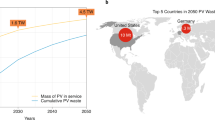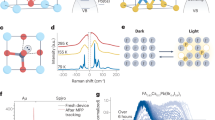Abstract
Effective recycling of spent perovskite solar modules will further reduce the energy requirements and environmental consequences of their production and deployment, thus facilitating their sustainable development. Here, through ‘cradle-to-grave’ life cycle assessments of a variety of perovskite solar cell architectures, we report that substrates with conducting oxides and energy-intensive heating processes are the largest contributors to primary energy consumption, global warming potential and other types of impact. We therefore focus on these materials and processes when expanding to ‘cradle-to-cradle’ analyses with recycling as the end-of-life scenario. Our results reveal that recycling strategies can lead to a decrease of up to 72.6% in energy payback time and a reduction of 71.2% in greenhouse gas emission factor. The best recycled module architecture can exhibit an extremely small energy payback time of 0.09 years and a greenhouse gas emission factor as low as 13.4 g CO2 equivalent per kWh; it therefore outcompetes all other rivals, including the market-leading silicon at 1.3–2.4 years and 22.1–38.1 g CO2 equivalent per kWh. Finally, we use sensitivity analyses to highlight the importance of prolonging device lifetime and to quantify the effects of uncertainty induced by the still immature manufacturing processes, changing operating conditions and individual differences for each module.
This is a preview of subscription content, access via your institution
Access options
Access Nature and 54 other Nature Portfolio journals
Get Nature+, our best-value online-access subscription
$29.99 / 30 days
cancel any time
Subscribe to this journal
Receive 12 digital issues and online access to articles
$119.00 per year
only $9.92 per issue
Buy this article
- Purchase on Springer Link
- Instant access to full article PDF
Prices may be subject to local taxes which are calculated during checkout





Similar content being viewed by others
Data availability
All data needed to evaluate the conclusions in the paper are present in the paper and/or the Supplementary Materials. The LCA modelling file with all data inputs, results, methodological notes, figures, discussion of uncertainties and sources is available on GitHub (https://github.com/PEESEgroup/Perovskite-Recycling-LCA). Additional data are available from the authors upon request.
References
Snaith, H. J. Perovskites: the emergence of a new era for low-cost, high-efficiency solar cells. J. Phys. Chem. Lett. 4, 3623–3630 (2013).
Best Research-Cell Efficiency Chart (NREL Transforming Energy, 2020); https://www.nrel.gov/pv/cell-efficiency.html
Berry, J. J. et al. Perovskite photovoltaics: the path to a printable terawatt-scale technology. ACS Energy Lett. 2, 2540–2544 (2017).
Bonnet, D. The CdTe thin film solar cell - an overview. Int. J. Sol. Energy 12, 1–14 (1992).
Kojima, A., Teshima, K., Shirai, Y. & Miyasaka, T. Organometal halide perovskites as visible-light sensitizers for photovoltaic cells. J. Am. Chem. Soc. 131, 6050–6051 (2009).
Li, Z. et al. Scalable fabrication of perovskite solar cells. Nat. Rev. Mater. 3, 18017 (2018).
Gong, J., Darling, S. B. & You, F. Perovskite photovoltaics: life-cycle assessment of energy and environmental impacts. Energy Environ. Sci. 8, 1953–1968 (2015).
Kim, B. J. et al. Selective dissolution of halide perovskites as a step towards recycling solar cells. Nat. Commun. 7, 11735 (2016).
Kadro, J. M. & Hagfeldt, A. The end-of-life of perovskite PV. Joule 1, 29–46 (2017).
Alberola-Borràs, J.-A. et al. Perovskite photovoltaic modules: life cycle assessment of pre-industrial production process. iScience 9, 542–551 (2018).
Song, Z. et al. A technoeconomic analysis of perovskite solar module manufacturing with low-cost materials and techniques. Energy Environ. Sci. 10, 1297–1305 (2017).
Shin, S. S. et al. Colloidally prepared La-doped BaSnO3 electrodes for efficient, photostable perovskite solar cells. Science 356, 167–171 (2017).
Kim, Y. C. et al. Engineering interface structures between lead halide perovskite and copper phthalocyanine for efficient and stable perovskite solar cells. Energy Environ. Sci. 10, 2109–2116 (2017).
You, J. et al. Improved air stability of perovskite solar cells via solution-processed metal oxide transport layers. Nat. Nanotechnol. 11, 75–81 (2016).
Saliba, M. et al. Cesium-containing triple cation perovskite solar cells: improved stability, reproducibility and high efficiency. Energy Environ. Sci. 9, 1989–1997 (2016).
Yang, S., Fu, W., Zhang, Z., Chen, H. & Li, C.-Z. Recent advances in perovskite solar cells: efficiency, stability and lead-free perovskite. J. Mater. Chem. A 5, 11462–11482 (2017).
Islam, M. B., Yanagida, M., Shirai, Y., Nabetani, Y. & Miyano, K. Highly stable semi-transparent MAPbI3 perovskite solar cells with operational output for 4000 h. Sol. Energy Mater. Sol. Cells 195, 323–329 (2019).
Bi, D. et al. Efficient luminescent solar cells based on tailored mixed-cation perovskites. Sci. Adv. 2, e1501170 (2016).
Dang, M. T., Lefebvre, J. & Wuest, J. D. Recycling indium tin oxide (ITO) electrodes used in thin-film devices with adjacent hole-transport layers of metal oxides. ACS Sustain. Chem. Eng. 3, 3373–3381 (2015).
Kadro, J. M. et al. Proof-of-concept for facile perovskite solar cell recycling. Energy Environ. Sci. 9, 3172–3179 (2016).
Rebitzer, G. et al. Life cycle assessment: Part 1: Framework, goal and scope definition, inventory analysis, and applications. Environ. Int. 30, 701–720 (2004).
Pennington, D. et al. Life cycle assessment Part 2: Current impact assessment practice. Environ. Int. 30, 721–739 (2004).
Goetz, K. P., Taylor, A. D., Hofstetter, Y. J. & Vaynzof, Y. Sustainability in perovskite solar cells. ACS Appl. Mater. Interfaces 13, 1–17 (2021).
Conings, B., Babayigit, A. & Boyen, H.-G. Fire safety of lead halide perovskite photovoltaics. ACS Energy Lett. 4, 873–878 (2019).
Espinosa, N., Serrano-Luján, L., Urbina, A. & Krebs, F. C. Solution and vapour deposited lead perovskite solar cells: ecotoxicity from a life cycle assessment perspective. Sol. Energy Mater. Sol. Cells 137, 303–310 (2015).
Goedkoop, M. et al. ReCiPe 2008: A Life Cycle Impact Assessment Method Which Comprises Harmonised Category Indicators at the Midpoint and the Endpoint Level: Report 1: Characterisation (Ministry of Housing, Spatial Planning and Environment (VROM), 2009).
Mudd, G. M. Global trends in gold mining: towards quantifying environmental and resource sustainability. Resour. Policy 32, 42–56 (2007).
Maranghi, S., Parisi, M. L., Basosi, R. & Sinicropi, A. Environmental profile of the manufacturing process of perovskite photovoltaics: harmonization of life cycle assessment studies. Energies 12, 3746 (2019).
Alsema, E. & de Wild, M. J. Environmental impact of crystalline silicon photovoltaic module production. MRS Proc. 895, 73–78 (2006).
Raugei, M., Bargigli, S. & Ulgiati, S. Life cycle assessment and energy pay-back time of advanced photovoltaic modules: CdTe and CIS compared to poly-Si. Energy 32, 1310–1318 (2007).
Alsema, E., de Wild-Scholten, M. & Fthenakis, V. Environmental impacts of PV electricity generation-a critical comparison of energy supply options. In 21st European Photovoltaic Solar Energy Conference: Proceedings of the International Conference Held in Dresden, Germany, 4–8 September 2006 3201–3207 (WIP Renewable Energies, 2006).
Fthenakis, V. M. Life cycle impact analysis of cadmium in CdTe PV production. Renew. Sust. Energ. Rev. 8, 303–334 (2004).
Fthenakis, V. et al. Emissions and encapsulation of cadmium in CdTe PV modules during fires. Prog. Photovolt. Res. Appl. 13, 713–723 (2005).
Darling, S. B. & You, F. The case for organic photovoltaics. RSC Adv. 3, 17633–17648 (2013).
Matteocci, F. et al. High efficiency photovoltaic module based on mesoscopic organometal halide perovskite. Prog. Photovolt. Res. Appl. 24, 436–445 (2016).
Liu, D. & Kelly, T. L. Perovskite solar cells with a planar heterojunction structure prepared using room-temperature solution processing techniques. Nat. Photon. 8, 133–138 (2014).
Xu, Y., Li, J., Tan, Q., Peters, A. L. & Yang, C. Global status of recycling waste solar panels: a review. Waste Manag. 75, 450–458 (2018).
Yue, D., Khatav, P., You, F. & Darling, S. B. Deciphering the uncertainties in life cycle energy and environmental analysis of organic photovoltaics. Energy Environ. Sci. 5, 9163–9172 (2012).
Espinosa, N., Hösel, M., Angmo, D. & Krebs, F. C. Solar cells with one-day energy payback for the factories of the future. Energy Environ. Sci. 5, 5117–5132 (2012).
Goe, M. & Gaustad, G. Strengthening the case for recycling photovoltaics: An energy payback analysis. Appl. Energy 120, 41–48 (2014).
Espinosa, N., García-Valverde, R. & Krebs, F. C. Life-cycle analysis of product integrated polymer solar cells. Energy Environ. Sci. 4, 1547–1557 (2011).
García-Valverde, R., Cherni, J. A. & Urbina, A. Life cycle analysis of organic photovoltaic technologies. Prog. Photovolt. Res. Appl. 18, 535–558 (2010).
Siefert, W. Corona spray pyrolysis: a new coating technique with an extremely enhanced deposition efficiency. Thin Solid Films 120, 267–274 (1984).
Frischknecht, R. LCI modelling approaches applied on recycling of materials in view of environmental sustainability, risk perception and eco-efficiency. Int. J. Life Cycle Assess. 15, 666–671 (2010).
IPCC Climate Change 2013: The Physical Science Basis (eds. Stocker, T. F. et al.) (Cambridge Univ. Press, 2013).
Goedkoop, M. The Eco-indicator 99: A Damage Oriented Method for Life Cycle Impact Assessment (PRé Consultants, 2000).
Fthenakis, V. M., Kim, H. C. & Alsema, E. Emissions from photovoltaic life cycles. Environ. Sci. Technol. 42, 2168–2174 (2008).
Darling, S. B., You, F., Veselka, T. & Velosa, A. Assumptions and the levelized cost of energy for photovoltaics. Energy Environ. Sci. 4, 3133–3139 (2011).
Goodrich, A., James, T. & Woodhouse, M. Residential, Commercial, and Utility-Scale Photovoltaic (PV) System Prices in the United States: Current Drivers and Cost-Reduction Opportunities (NREL, 2012).
Sofia, S. E. et al. Economic viability of thin-film tandem solar modules in the United States. Nat. Energy 3, 387–394 (2018).
Yang, W. S. et al. Iodide management in formamidinium-lead-halide–based perovskite layers for efficient solar cells. Science 356, 1376–1379 (2017).
Jiang, Q. et al. Planar-structure perovskite solar cells with efficiency beyond 21%. Adv. Mater. 29, 1703852 (2017).
Acknowledgements
This work was supported in part by a National Science Foundation (NSF) CAREER award (CBET-1643244). S.D.S. acknowledges support from the Royal Society and Tata Group (UF150033).
Author information
Authors and Affiliations
Contributions
F.Y. conceived the research; X.T. developed the models and conducted the simulations; X.T. and F.Y. analysed the results; X.T., S.D.S. and F.Y. wrote the manuscript. All authors reviewed the final manuscript.
Corresponding author
Ethics declarations
Competing interests
S.D.S. is a co-founder of Swift Solar. All other authors have no competing interests.
Additional information
Peer review information Nature Sustainability thanks Adalgisa Sinicropi and the other, anonymous, reviewer(s) for their contribution to the peer review of this work.
Publisher’s note Springer Nature remains neutral with regard to jurisdictional claims in published maps and institutional affiliations.
Extended data
Extended Data Fig. 1 Environmental profile of a 1 m2 LBSO module.
Detailed breakdowns of 18 midpoint impact categories according to the ReCiPe method for LBSO module.
Extended Data Fig. 2 Environmental profile of a 1 m2 defect-engineered module.
Detailed breakdowns of 18 midpoint impact categories according to the ReCiPe method for defect-engineered module.
Extended Data Fig. 3 Comparative LCIA results among the six investigated modules.
Normalized LCIA results with LBSO module defined as the base case for normalization.
Extended Data Fig. 4 Uncertainty analysis for the LBSO module in terms of EPBT and GHG emission factor.
Probability and frequency statistics for EPBT and GHG emission factor based on Monte Carlo simulations.
Extended Data Fig. 5 Sensitivity analysis for the LBSO module in terms of EPBT and GHG emission factor.
Sensitivity analysis for EPBT and GHG emission factor based on Monte Carlo simulations.
Extended Data Fig. 6 Sensitivity analysis for recycling the LBSO module in terms of primary energy consumption and global warming potential.
Tornado charts of the sensitivity analysis results for producing recycled LBSO module.
Supplementary information
Supplementary Information
Supplementary Figs. 1–45, Discussion, Tables 1–46 and references 1–34.
Rights and permissions
About this article
Cite this article
Tian, X., Stranks, S.D. & You, F. Life cycle assessment of recycling strategies for perovskite photovoltaic modules. Nat Sustain 4, 821–829 (2021). https://doi.org/10.1038/s41893-021-00737-z
Received:
Accepted:
Published:
Issue Date:
DOI: https://doi.org/10.1038/s41893-021-00737-z
This article is cited by
-
Recent progress of eco-friendly manufacturing process of efficient perovskite solar cells
Nano Convergence (2023)
-
Bioinspired “cage traps” for closed-loop lead management of perovskite solar cells under real-world contamination assessment
Nature Communications (2023)
-
Lead immobilization for environmentally sustainable perovskite solar cells
Nature (2023)
-
Porous organic polycarbene nanotrap for efficient and selective gold stripping from electronic waste
Nature Communications (2023)
-
Sustainability considerations for organic electronic products
Nature Materials (2023)



